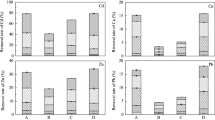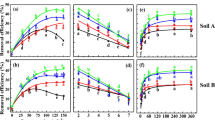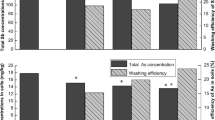Abstract
Food waste fermentation generates complicated organic and acidic liquids with low pH. In this work, it was found that an organic acid liquid with pH 3.28 and volatile low-molecular-weight organic acid (VLMWOA) content of 5.2 g/L could be produced from food wastes after 9-day fermentation. When the liquid-to-solid ratio was 50:1, temperature was 40 °C, and contact time was 0.5–1 day, 92.9, 78.8, and 52.2% of the Cd, Cu, and Zn in the contaminated soil could be washed out using the fermented food waste liquid, respectively. The water-soluble, acid-soluble, and partly reducible heavy metal fractions can be removed after 0.5-day contact time, which was more effective than that using commercially available VLMWOAs (29–72% removal), as the former contained microorganisms and adequate amounts of nutrients (nitrogen, phosphorous, and exchangeable Na, K, and Ca) which favored the washing process of heavy metals. It is thus suggested that the organic acid fractions from food waste has a considerable potential for reclaiming contaminated soil while improving soil fertility.





Similar content being viewed by others
References
Abumaizar RJ, Smith EH (1999) Heavy metal contaminants removal by soil washing. J Hazard Mater 70:71–86
APHA (1998) Standard methods for the examination of water and wastewater, 20th edn. American Public Health Association, Washington D.C
Ash C, Drábek O, Tejnecký V, Jehlička J, Michon N, Borůvka L (2016a) Sustainable soil washing: shredded card filtration of potentially toxic elements after leaching from soil using organic acid solutions. PLoS One 11:e0149882
Ash C, Tejnecký V, Borůvka L, Drábek O (2016b) Different low-molecular-mass organic acids specifically control leaching of arsenic and lead from contaminated soil. J Contam Hydrol 187:18–30
Babel S, Dacera DDM (2006) Heavy metal removal from contaminated sludge for land application: a review. Waste Manag 26:988–1004
Bationo A, Mokwunye A (1991) Role of manures and crop residue in alleviating soil fertility constraints to crop production: with special reference to the Sahelian and Sudanian zones of West Africa. In: Alleviating soil fertility constraints to increased crop production in West Africa. Springer, pp 217–225
Bosecker K (1997) Bioleaching: metal solubilization by microorganisms. FEMS Microbiol Rev 20:591–604
Cannan RK, Kibrick A (1938) Complex formation between carboxylic acids and divalent metal cations. J Am Chem Soc 60:2314–2320
Chen ZH, Ping HU, Shao YP, Ping HU, Shi XU, Ming HE (2003) Physico-chemical properties of the main agro-soils in Jiading District, Shanghai Journal of Shanghai Jiaotong University
Chiang P-N, Tong O-Y, Chiou C-S, Lin Y-A, Wang M-K, Liu C-C (2016) Reclamation of zinc-contaminated soil using a dissolved organic carbon solution prepared using liquid fertilizer from food-waste composting. J Hazard Mater 301:100–105
Chu W, Chan KH (2003) The mechanism of the surfactant-aided soil washing system for hydrophobic and partial hydrophobic organics. Sci Total Environ 307:83–92
Dacera DM, Babel S (2007) Heavy metals removal from contaminated sewage sludge by naturally fermented raw liquid from pineapple wastes. Water Sci Technol J Int Assoc Water Pollut Res 56:145–152
Dacera D, Babel S (2008) Removal of heavy metals from contaminated sewage sludge using Aspergillus niger fermented raw liquid from pineapple wastes. Bioresour Technol 99:1682–1689
Dacera DDM, Babel S, Parkpian P (2009) Potential for land application of contaminated sewage sludge treated with fermented liquid from pineapple wastes. J Hazard Mater 167:866–872
Dijkstra JJ, Meeussen JC, Comans RN (2004) Leaching of heavy metals from contaminated soils: an experimental and modeling study. Environmental Science & Technology 38:4390–4395
Ghosh M, Singh SP (2005) A review on phytoremediation of heavy metals and utilization of its byproducts. Appl Ecol Environ Res 3:1–18
Gogo S, Shreeve T, Pearce D (2010) Geochemistry of three contrasting British peatlands: complex patterns of cation availability and implications for microbial metabolism. Geoderma 158:207–215
Gonzalez-Silva BM, Briones-Gallardo R, Razo-Flores E, Celis LB (2009) Inhibition of sulfate reduction by iron, cadmium and sulfide in granular sludge. J Hazard Mater 172:400–407. doi:10.1016/j.jhazmat.2009.07.022
Guven DE, Akinci G (2008) Heavy metals partitioning in the sediments of Izmir Inner Bay. J Environ Sci 20:413–418
Heider J, Fuchs G (1997) Anaerobic metabolism of aromatic compounds. Eur J Biochem 243:577–596
Li Y, He D, Niu D, Zhao Y (2015) Acetic acid production from food wastes using yeast and acetic acid bacteria micro-aerobic fermentation. Bioprocess Biosyst Eng 38:863–869
Li Y, Zhou T, Chen S, Zhang J, Song L, Zhao Y (2016) Effects of temperature on the production of acetic acid from food wastes by yeast and acetic acid bacteria during micro-aerobic fermentation. China Environ Sci (In Chinese) 36:175–180
Liu C-C, Lin Y-C (2013) Reclamation of copper-contaminated soil using EDTA or citric acid coupled with dissolved organic matter solution extracted from distillery sludge. Environ Pollut 178:97–101
Meulepas RJW, Gonzalez-Gil G, Teshager FM, Witharana A, Saikaly PE, Lens PNL (2015) Anaerobic bioleaching of metals from waste activated sludge. Sci Total Environ 514:60–67
Nelson D, Sommers L (1996) Total carbon, organic carbon, and organic matter methods of soil analysis part 3—chemical methods: 961–1010
Rohwerder T, Gehrke T, Kinzler K, Sand W (2003) Bioleaching review part A: progress in bioleaching: fundamentals and mechanisms of bacterial metal sulfide oxidation. Appl Microbiol Biotechnol 63:239–248
Schwab AP, He Y, Banks MK (2005) The influence of organic ligands on the retention of lead in soil. Chemosphere 61:856–866
Selling R, Håkansson T, Björnsson L (2008) Two-stage anaerobic digestion enables heavy metal removal. Water Sci Technol J Int Assoc Water Pollut Res 57:553–558
Thyberg KL, Tonjes DJ, Gurevitch J (2015) Quantification of food waste disposal in the United States: a meta-analysis. Environmental Science & Technology. doi:10.1021/acs.est.5b03880
Wang Q, Dong Y, Cui Y, Liu X (2001) Instances of soil and crop heavy metal contamination in China. Soil Sediment Contam 10:497–510
Wang XW, Qiu XT, Geng-Sheng JI, Yong Q, Shi-Yuan YU (2007) Effects of inhibitors and circumstance factors on fermentation by free or immobilized yeasts Acta Agriculturae Universitatis Jiangxiensis
Wang G, Zhang S, Xu X, Li T, Li Y, Deng O, Gong G (2014) Efficiency of nanoscale zero-valent iron on the enhanced low molecular weight organic acid removal Pb from contaminated soil. Chemosphere 117:617–624
Wang G et al (2016) Heavy metal removal by GLDA washing: optimization, redistribution, recycling, and changes in soil fertility. Sci Total Environ 569–570:557–568. doi:10.1016/j.scitotenv.2016.06.155
Wasay SA, Barrington SF, Tokunaga S (1998) Remediation of soils polluted by heavy metals using salts of organic acids and chelating agents. Environ Technol 19:369–379. doi:10.1080/09593331908616692
Wu Q, Cui Y, Li Q, Sun J (2014) Effective removal of heavy metals from industrial sludge with the aid of a biodegradable chelating ligand GLDA. J Hazard Mater 283C:748–754
Yao Z, Li J, Xie H, Yu C (2012) Review on remediation technologies of soil contaminated by heavy metals. Procedia Environ Sci 16:722–729
Ye M et al (2017) Bioleaching combined brine leaching of heavy metals from lead-zinc mine tailings: transformations during the leaching process. Chemosphere 168:1115
Zhang Y, Wang XC, Cheng Z, Li Y, Tang J (2015) Effect of fermentation liquid from food waste as a carbon source for enhancing denitrification in wastewater treatment. Chemosphere 144:689–696
Acknowledgements
This study was financially supported by the State Key Laboratory of Pollution Control and Resource Reuse, Tongji University (Grant no. PCRRK14001) and the National Key Technologies R&D Program of China (grant no. 2014BAL02B05).
Author information
Authors and Affiliations
Corresponding author
Additional information
Responsible editor: Philippe Garrigues
Highlights
1. Fermented liquid with pH = 3.28 was produced after the fermentation of food wastes for 9 days.
2. The Cd, Cu, and Zn washing rate from the contaminated soil reached the maximum value of 90%.
3. FLFW is more effective at heavy metal washing under acidic conditions than commercially available VLMWOAs.
4. Soil fertility was enhanced after soil was washed by the organic acid liquid.
Rights and permissions
About this article
Cite this article
Dai, S., Li, Y., Zhou, T. et al. Reclamation of heavy metals from contaminated soil using organic acid liquid generated from food waste: removal of Cd, Cu, and Zn, and soil fertility improvement. Environ Sci Pollut Res 24, 15260–15269 (2017). https://doi.org/10.1007/s11356-017-9139-6
Received:
Accepted:
Published:
Issue Date:
DOI: https://doi.org/10.1007/s11356-017-9139-6




